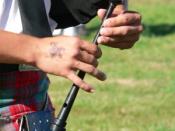Webster's dictionary defines the bagpipe as a wind instrument consisting of a reed melody pipe and from one to five drones with air supplied continuously either by a bag with valve-stopped mouth tube or by bellows.
The bagpipes can be found referenced thousands of years ago, the earliest mention dating back to 400 BC. Aristophanes a poet from Athens insulted enemies of Athens by saying they played instruments consisting of dog skin and chanters of bone. The chanter is the part of the instrument wherethe fingers are placed to create different melodies.
Although bagpipes are commonly associated with the country of Scotland, because of its role it took in replacing the harp in Celtic music, but it is a mystery as to where the instrument originated from. The word "sumponyah" appears in the book of Daniel in the Bible and in modern translations is translated to the word "bagpipe". Even the Roman Emperor Nero is believed to have been a player of the bagpipes as revenge for losing poetry competitions.
Bagpipes are made up of three different parts: the chanter, the bag holding the reservoir of air, and the drones. The bags are usually made of a material called Gore-Tex and since the 1990's have moisture systems which prevent moisture from the players breath from condensing on the inside of the bag and damaging it. The drones are the long pipes which are rested on the players shoulders, there are three drones; two tenor drones and one bass drone. The chanter is usually louder than the drones, and plays the main melody while the drones supply the background music.
All bagpipes work in the same way; the pipe bag holds air which is always supplying air to the chanter (playing the tune) and to the drones which play a background...



Bagpipe history
Very interesting. I will keep this in mind when I need an essay about bagpipes!!!
0 out of 0 people found this comment useful.